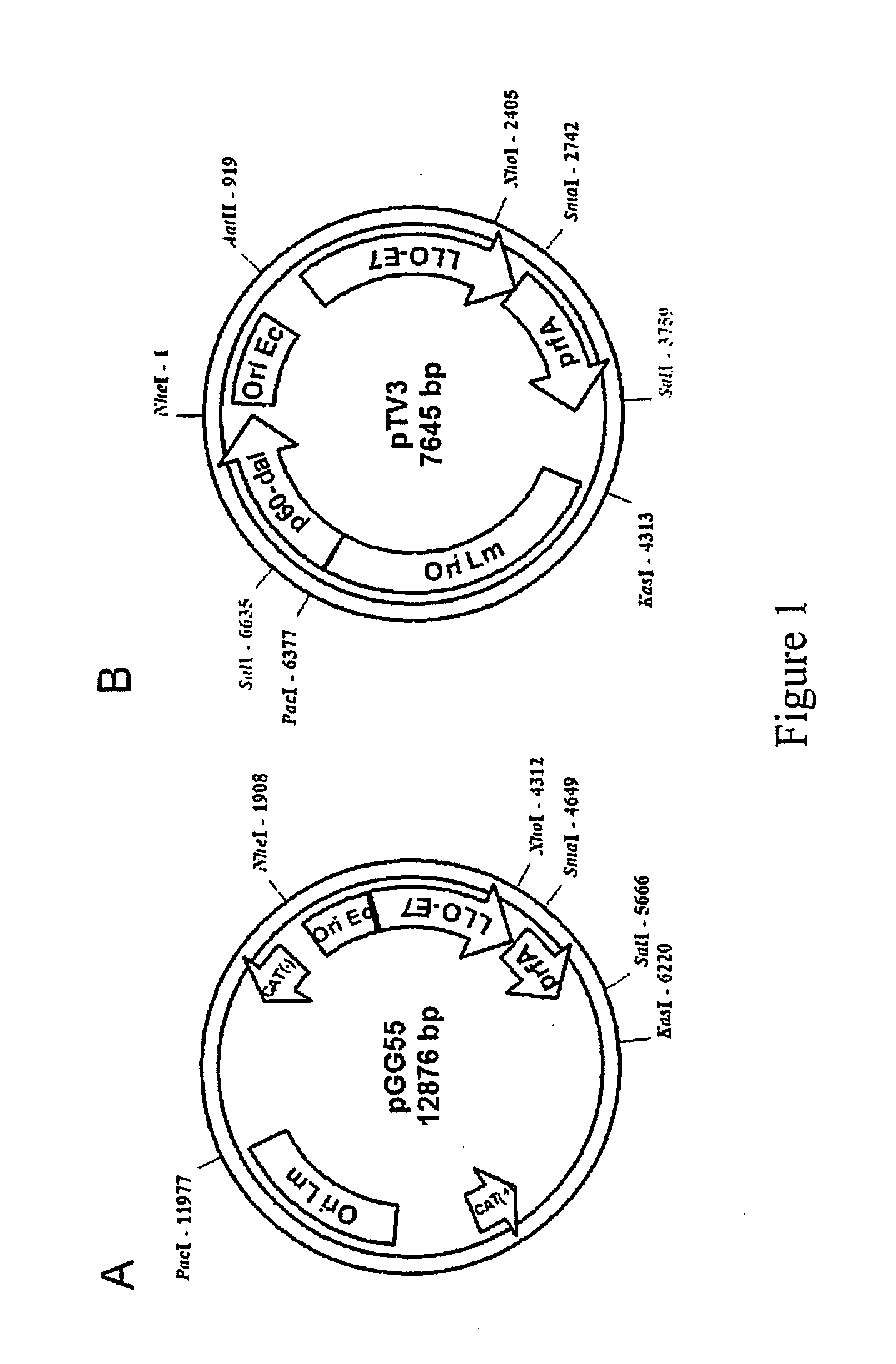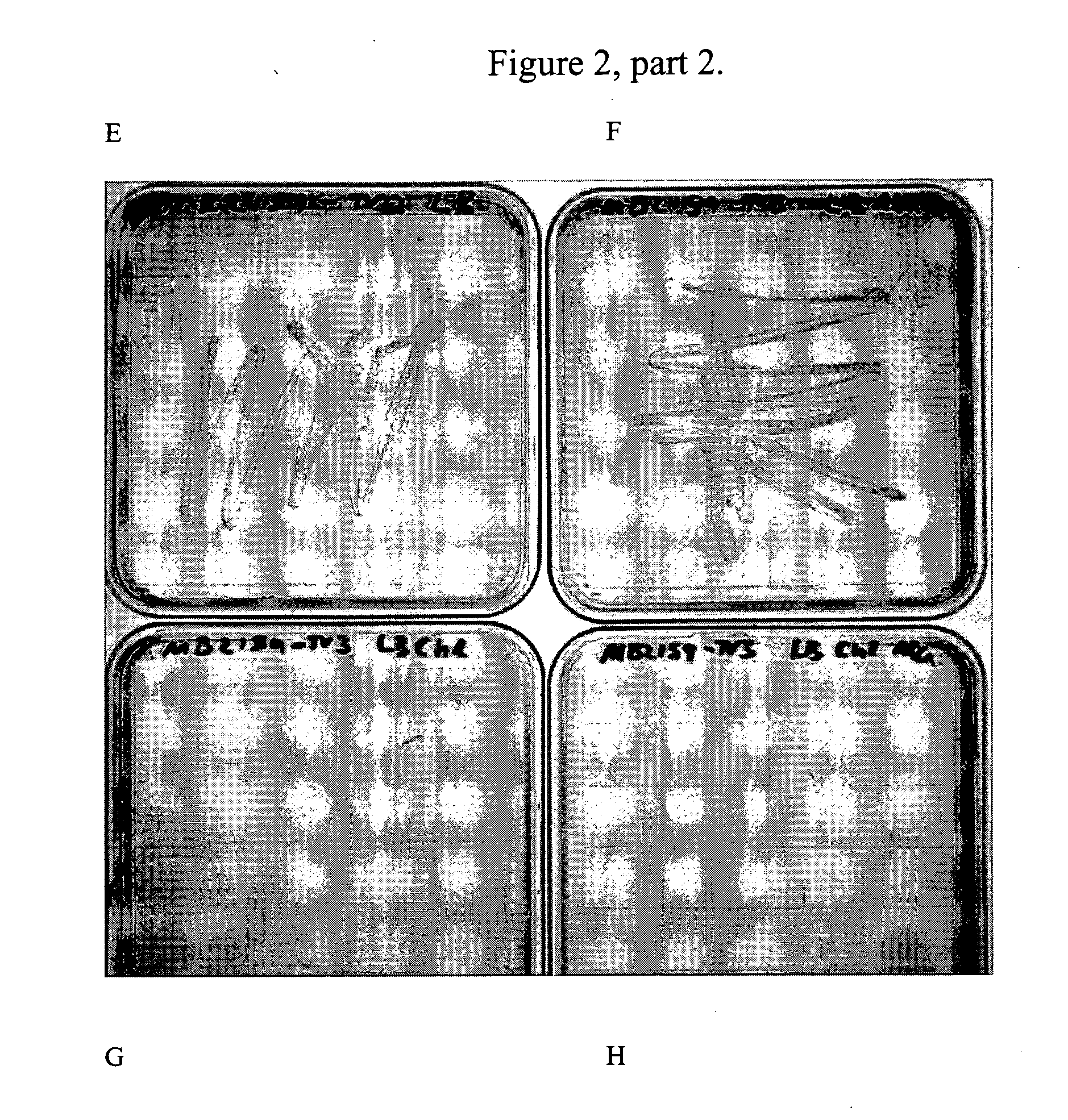Methods for constructing antibiotic resistance free vaccines
a technology of antibiotic resistance and free vaccines, which is applied in the field of dna vaccines comprising an antibiotic resistance genefree plasmid, can solve the problems of limited immunity, ineffective traditional vaccine strategies, and ineffective in combating intracellular organisms or neoplasias that require cell mediated
- Summary
- Abstract
- Description
- Claims
- Application Information
AI Technical Summary
Benefits of technology
Problems solved by technology
Method used
Image
Examples
example 1
A Plasmid Containing an Amino Acid Metabolism Enzyme Instead of an Antibiotic Resistance Gene is Retained in Auxotrophic Bacteria both in Vitro and in Vivo
Material and Experimental Methods
Transformation and Selection
[0075]E. coli strain MB2159 was used for transformations, using standard protocols. Bacterial cells were prepared for electroporation by washing with H2O.
Bacterial Culture and In Vivo Passaging of E. coli
[0076]E. coli were cultured following standard methods. For growth kinetics determinations, bacteria were grown for 16 hours in 10 ml of LB+antibiotics. The OD600 nm was measured and culture densities were normalized between the strains. The culture was diluted 1:50 into LB+suitable antibiotics and D-alanine if applicable.
Construction of Antibiotic Resistance Factor Free Plasmid pTV3
[0077] The starting point for subcloning of pGG55 was the plasmid pDP1659. pDP1659 was generated by PCR (polymerase chain reaction)-amplifying from LM genomic DNA the DNA fragment en...
example 2
Purification of a Plasmid Containing an Amino Acid Metabolism Enzyme for Use as a DNA Vaccine
[0092] The auxotrophic bacteria transformed with the plasmid DNA vaccine pTV3 were lysed, and the plasmid DNA was isolated and purified using standard methods. Plasmids were purified using Qiagen plasmid mega kits (Qiagen Sciences, Maryland). DNA concentration was determined by the absorbance measured at 260 nm. The presence of the insert was confirmed by restriction enzyme digestion and gel electrophoresis. The plasmid DNA vaccine was restriction digested, run on an agarose gel, and stained with ethidium bromide (FIG. 3), showing the successful isolation of the plasmid.
[0093] Thus, a DNA plasmid without an antibiotic resistance gene can be propagated in an auxotrophic bacteria and isolated for use as a plasmid DNA vaccine.
example 3
DNA Vaccines Carrying Plasmids Containing a Metabolic Enzyme Mediate Antigen Expression
[0094] Antigen expression from the metabolic enzyme-containing plasmid was tested in vitro by Western blot, by transforming an auxotrophic LM strains (Lmdd), using an plasmid containing an antibiotic resistance gene for comparison. When analyzing equal amounts of total protein from bacterial culture supernatants, Lmdd-TV3 cultures contained approximately double the amount of total antigen than Lm-LLOE7 cultures. This difference may be a result of a higher overall metabolic load in Lm-LLOE7, due to the larger size of the plasmid (12.8 kB) compared to Lmdd-TV3 (7.6 kB).
[0095] Thus, plasmids containing metabolic enzymes instead of antibiotic resistance genes are efficacious vehicles for expression of heterologous proteins, and thus have utility in DNA vaccines.
PUM
| Property | Measurement | Unit |
|---|---|---|
| Electrical resistance | aaaaa | aaaaa |
| Acidity | aaaaa | aaaaa |
Abstract
Description
Claims
Application Information
 Login to View More
Login to View More - R&D
- Intellectual Property
- Life Sciences
- Materials
- Tech Scout
- Unparalleled Data Quality
- Higher Quality Content
- 60% Fewer Hallucinations
Browse by: Latest US Patents, China's latest patents, Technical Efficacy Thesaurus, Application Domain, Technology Topic, Popular Technical Reports.
© 2025 PatSnap. All rights reserved.Legal|Privacy policy|Modern Slavery Act Transparency Statement|Sitemap|About US| Contact US: help@patsnap.com



